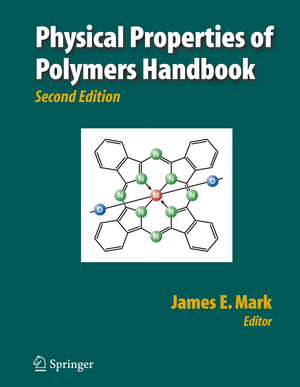Physical Properties of Polymers Handbook
Editat de James E. Marken Limba Engleză Hardback – 18 dec 2006
This handbook offers concise information on the properties of polymeric materials, particularly those most relevant to the areas of physical chemistry and chemical physics. In the second edition of Physical Properties of Polymers Handbook, each chapter has been extensively updated and revised. The number of chapters have increased from 52 to 63 to include novel polymeric structures, specifically rotaxanes and related materials, self-assembly materials, foldamer supramolecular structures, tribology, mechanical properties of single molecules, and dendrimers, as well as reinforcing phases in polymers, including carbon black, silica, clays and other layered fillers, POSS, carbon nanotubes, and reinforcement theory. The study of complex materials is highly interdisciplinary, and new findings arescattered among a large selection of scientific and engineering journals. Physical Properties of Polymers Handbook is a comprehensive and authoritative compilation that brings together data and supporting information from experts in the different disciplines contributing to the rapidly growing area of polymers and complex materials.
Preț: 3630.67 lei
Preț vechi: 4427.64 lei
-18% Nou
Puncte Express: 5446
Preț estimativ în valută:
694.82€ • 722.72$ • 573.61£
694.82€ • 722.72$ • 573.61£
Carte tipărită la comandă
Livrare economică 14-28 aprilie
Preluare comenzi: 021 569.72.76
Specificații
ISBN-13: 9780387312354
ISBN-10: 0387312358
Pagini: 1076
Ilustrații: XX, 1076 p.
Dimensiuni: 216 x 280 x 64 mm
Greutate: 2.5 kg
Ediția:2nd ed. 2007
Editura: Springer
Colecția Springer
Locul publicării:New York, NY, United States
ISBN-10: 0387312358
Pagini: 1076
Ilustrații: XX, 1076 p.
Dimensiuni: 216 x 280 x 64 mm
Greutate: 2.5 kg
Ediția:2nd ed. 2007
Editura: Springer
Colecția Springer
Locul publicării:New York, NY, United States
Public țintă
ResearchCuprins
Structure.- Chain Structures.- Names, Acronyms, Classes, and Structures of Some Important Polymers.- Theory.- The Rotational Isomeric State Model.- Computational Parameters.- Theoretical Models and Simulations of Polymer Chains.- Scaling, Exponents, and Fractal Dimensions.- Thermodynamic Properties.- Densities, Coefficients of Thermal Expansion, and Compressibilities of Amorphous Polymers.- Thermodynamic Properties of Proteins.- Heat Capacities of Polymers.- Thermal Conductivity.- Thermodynamic Quantities Governing Melting.- The Glass Temperature.- Sub-T g Transitions.- Polymer–Solvent Interaction Parameter ?.- Theta Temperatures.- Solubility Parameters.- Mark–Houwink–Staudinger–Sakurada Constants.- Polymers and Supercritical Fluids.- Thermodynamics of Polymer Blends.- Spectroscopy.- NMR Spectroscopy of Polymers.- Broadband Dielectric Spectroscopy to Study the Molecular Dynamics of Polymers Having Different Molecular Architectures.- Group Frequency Assignments for Major Infrared BandsObserved in Common Synthetic Polymers.- Small Angle Neutron and X-Ray Scattering.- Mechanical Properties.- Mechanical Properties.- Chain Dimensions and Entanglement Spacings.- Temperature Dependences of the Viscoelastic Response of Polymer Systems.- Adhesives.- Some Mechanical Properties of Typical Polymer-Based Composites.- Polymer Networks and Gels.- Force Spectroscopy of Polymers: Beyond Single Chain Mechanics.- Reinforcing Phases.- Carbon Black.- Properties of Polymers Reinforced with Silica.- Physical Properties of Polymer/Clay Nanocomposites.- Polyhedral Oligomeric Silsesquioxane (POSS).- Carbon Nanotube Polymer Composites: Recent Developments in Mechanical Properties.- Reinforcement Theories.- Crystallinity and Morphology.- Densities of Amorphous and Crystalline Polymers.- Unit Cell Information on Some Important Polymers.- Crystallization Kinetics of Polymers.- Block Copolymer Melts.- Polymer Liquid Crystals and Their Blends.- The Emergence of a New Macromolecular Architecture:“The Dendritic State”.- Polyrotaxanes.- Foldamers: Nanoscale Shape Control at the Interface Between Small Molecules and High Polymers.- Recent Advances in Supramolecular Polymers.- Electrical, Optical and Magnetic Properties.- Conducting Polymers: Electrical Conductivity.- Electroluminescent Polymer Systems.- Magnetic, Piezoelectric, Pyroelectric, and Ferroelectric Properties of Synthetic and Biological Polymers.- Nonlinear Optical Properties of Polymers.- Refractive Index, Stress-Optical Coefficient, and Optical Configuration Parameter of Polymers.- Responses to Radiation, Heat, and Chemical Agents.- Ultraviolet Radiation and Polymers.- The Effects of Electron Beam and g-Irradiation on Polymeric Materials.- Flammability.- Thermal-Oxidative Stability and Degradation of Polymers.- Synthetic Biodegradable Polymers for Medical Applications.- Biodegradability of Polymers.- Properties of Photoresist Polymers.- Pyrolyzability of Preceramic Polymers.- Other Properties.- Surface and Interfacial Properties.- Acoustic Properties of Polymers.- Permeability of Polymers to Gases and Vapors.- Miscellaneous.- Definitions.- Units and Conversion Factors.
Recenzii
From the reviews of the second edition:
"This edition of Physical Properties of Polymers Handbook is a mammoth undertaking with 63 chapters divided into nine parts and 100 distinguished contributors with affiliations in industry, academia, and governmental agencies. The objectives of the book are very ambitious. … The compilations of physical properties are very readable and, depending on one’s interests, range from the mundane and practical to the esoteric. … All in all, this is a very useful compendium and should have a place on every polymer scientist’s bookshelf." (George Christopher Martin, Journal of the American Chemical Society, Vol. 130 (3), 2008)
"This handbook covers an enormous range of properties of polymeric materials, particularly those relevant to the areas of physical chemistry and chemical physics. … It is a reference work for researchers or advanced students studying polymeric materials. … The main goal of the book is to discuss and describe important results and modern developments. … If the reader … wishes to work in polymer applications or related areas, this is a good book to have available." (Christian Brosseau, Optics and Photonics News, February, 2008)
"This edition of Physical Properties of Polymers Handbook is a mammoth undertaking with 63 chapters divided into nine parts and 100 distinguished contributors with affiliations in industry, academia, and governmental agencies. The objectives of the book are very ambitious. … The compilations of physical properties are very readable and, depending on one’s interests, range from the mundane and practical to the esoteric. … All in all, this is a very useful compendium and should have a place on every polymer scientist’s bookshelf." (George Christopher Martin, Journal of the American Chemical Society, Vol. 130 (3), 2008)
"This handbook covers an enormous range of properties of polymeric materials, particularly those relevant to the areas of physical chemistry and chemical physics. … It is a reference work for researchers or advanced students studying polymeric materials. … The main goal of the book is to discuss and describe important results and modern developments. … If the reader … wishes to work in polymer applications or related areas, this is a good book to have available." (Christian Brosseau, Optics and Photonics News, February, 2008)
Textul de pe ultima copertă
This handbook offers concise information on the properties of polymeric materials, particularly those most relevant to the areas of physical chemistry and chemical physics. In the second edition of Physical Properties of Polymers Handbook, each chapter has been extensively updated and revised. The number of chapters have increased from 52 to 63 to include novel polymeric structures, specifically rotaxanes and related materials, self-assembly materials, foldamer supramolecular structures, tribology, mechanical properties of single molecules, and dendrimers, as well as reinforcing phases in polymers, including carbon black, silica, clays and other layered fillers, POSS, carbon nanotubes, and reinforcement theory. The study of complex materials is highly interdisciplinary, and new findings are scattered among a large selection of scientific and engineering journals. Physical Properties of Polymers Handbook is a comprehensive and authoritative compilation that brings together data and supporting information from experts in the different disciplines contributing to the rapidly growing area of polymers and complex materials.
Caracteristici
Extensive updates and revisions to each chapter, including eleven new chapters on novel polymeric structures, reinforcing phases in polymers, and experiments on single polymer chains Provides concise information on the properties of polymeric materials, particularly those most relevant to the areas of physical chemistry and chemical physics Greatly reduces the effort in finding authoritative and useful information on a great range of polymers and their properties Brings together the work of leading experts from different disciplines who are contributing to the rapidly growing area of polymers and complex materials Includes supplementary material: sn.pub/extras


















